The 20 best AI chatbots
AI chatbots can perform a range of tasks to make life easier. Find the right fit by trying our AI agent—an advanced AI chatbot—for free.
Candace Marshall
Vice President, Product Marketing, AI and Automation
Last updated August 7, 2025
A guide to the 20 best AI chatbots
AI chatbots aren’t some futuristic novelty any more. They’ve become part of how we move through the world. Conversational intelligence Software is there when we want answers, recommendations, or support, and we expect it to be fast, accurate, and available on our terms. That same expectation carries over into customer experiences. People want instant help, but they also want to feel like they’re being understood.
According to the Zendesk Customer Experience Trends Report 2025, 64% of consumers say that when AI agents embody human-like traits—such as friendliness, empathy, and even a bit of personality—it builds trust and makes them more likely to engage. When conversational AI feels natural and approachable, it reflects well on your brand and strengthens customer confidence.
That makes choosing the right AI chatbot for your business a bigger deal than ever. After all, if you had to choose between chatting with warm, witty Jarvis from Iron Man or cold, calculating HAL from 2001: A Space Odyssey, who's threatening to lock the pod bay doors, who are you going with?
In this guide, we’ll walk you through the best AI chatbots available to help you find the one that fits your brand, your team, and your customers best.
More in this guide:
- What is an AI chatbot?
- AI chatbot comparison chart
- The 20 best AI chatbots
- How do AI chatbots work?
- How to choose the right AI chatbot software
- Frequently asked questions
- See why our AI agents are the best AI chatbots for CX
What is an AI chatbot?An AI chatbot is a computer programme that uses artificial intelligence, particularly natural language processing (NLP), to understand and respond to human conversation in a human-like way. This means they can learn, adapt, and even come up with brand-new responses, making conversations feel much more natural and helpful. |
AI chatbot comparison chart
The chart below offers a quick side-by-side comparison of AI chatbot platforms, including pricing, free trial availability, and ideal use cases.
|
Software |
Starting price |
Free trial |
Best for |
|
Zendesk |
$55 per agent/month (billed annually) |
14 days |
Customer experience and employee service |
|
ChatGPT |
$20 per month |
Unavailable |
General-purpose conversational AI |
|
Google Gemini |
$19.99 per month |
30 days |
Multimodal understanding |
|
Microsoft 365 Copilot |
$30 per user/month (billed annually) |
30 days |
Web search, chat, and image generation |
|
DeepSeek |
$0.27 per 1M input tokens and $1.10 per 1M output tokens |
Not applicable |
Coding and technical tasks |
|
Claude |
$17 per month (billed annually) |
Unavailable |
Creative writing and nuanced conversations |
|
Perplexity |
$20 per month |
Unavailable |
Research and real-time web access |
|
Meta AI |
Free |
Not applicable |
General conversational use |
|
Grok |
$3.00/M, $0.75 per cached input + $15/Minputagent/month (billed annually) |
Unavailable |
Real-time information access (integrated with X/Twitter) |
|
Jasper Chat |
$39 per seat/month (billed annually) |
7 days |
Marketing, branding and content generation |
|
Deep AI |
£4.99 per month + overage pricing |
Unavailable |
Generative AI |
|
Khanmigo |
$44 per year (billed annually), but free for teachers |
Unavailable |
Education and learning assistance |
|
Pi |
$0 per agent/month |
Not applicable |
Empathetic conversational AI and personalised support |
|
HuggingChat |
$9 per month (billed annually) |
Unavailable |
User privacy |
|
Character.ai |
£9.99 per user/month (billed annually) |
Unavailable |
Interactive storytelling and gaming |
|
Poe |
$19.99 per user/month |
Unavailable |
chatbot aggregation |
|
Chatsonic |
$16 per user/month (billed annually) |
Unavailable |
Content creation, marketing and SEO |
|
Copy.ai |
$36 per seat/month (billed annually) |
Unavailable |
Marketing and sales content |
|
ZenoChat |
£5.59 per month, for 150 creations and 100 MB storage (billed annually) |
Unavailable |
Writing assistance and content creation |
|
You.com |
$15 per agent/month (billed annually) |
Unavailable |
AI-powered search and conversational AI |
How do AI chatbots work?
AI chatbots use natural language processing (NLP), machine learning (ML) algorithms, and large language models (LLMs) to understand what people are saying and respond in ways that feel natural. Here's how the process works:
- Natural language understanding (NLU): Interprets the user’s message by identifying intent (“I want to reset my password”) and extracting key details (“password”).
- Dialogue management: Maintains the flow of the conversation, keeping track of context across messages so interactions feel connected and not robotic.
- Language generation: Uses pre-trained LLMs (like GPT) to craft thoughtful, human-like replies based on the user’s intent and conversation history.
- Knowledge retrieval: For real-time or business-specific info, chatbots tap into internal databases or knowledge bases or external sources (using Retrieval-Augmented Generation, or RAG) to give accurate, relevant answers.
Over time, AI chatbots improve their understanding and performance, making them more effective in addressing queries and engaging in dynamic conversations.
The 20 best AI chatbots
With so many AI agents available, it helps to know which ones are built for what. Whether you’re looking for customer service automation, creative brainstorming, or personalised research, these 20 AI chatbots offer a range of capabilities to match how you work and communicate.
- Zendesk: Best for customer experience and employee service
- ChatGPT: Best for general-purpose conversations and content generation
- Google Gemini: Best for multimodal understanding and creation
- Microsoft Copilot: Best for productivity within Microsoft 365
- Deepseek: Best for technical tasks and code generation
- Claude: Best for thoughtful writing, analysis, and code work
- Perplexity: Best for research, real-time search, and source-backed answers
- Meta AI: Best for creative content across Meta platforms
- Grok: Best for engaging, personality-driven chats on X
- Jasper Chat: Best for brand-aligned marketing content
- Deep AI: Best for creators who want image and text generation tools
- Khanmigo: Best for AI-powered tutoring and classroom support
- Pi: Best for personal support, empathy, and idea-sharing
- HuggingChat: Best for experimenting with open-source AI models
- Character.ai: Best for interactive storytelling and AI personas
- Poe: Best for switching between top AI models in one place
- Chatsonic: Best for real-time content generation with marketing tools
- Copy.ai: Best for scaling content creation with copywriting templates
- ZenoChat: Best for AI writing assistance and content creation
- You.com: Best for AI-powered search, conversational AI, and access to various AI models and agents.
1. Zendesk
Best for customer experience and employee service
Model: Proprietary
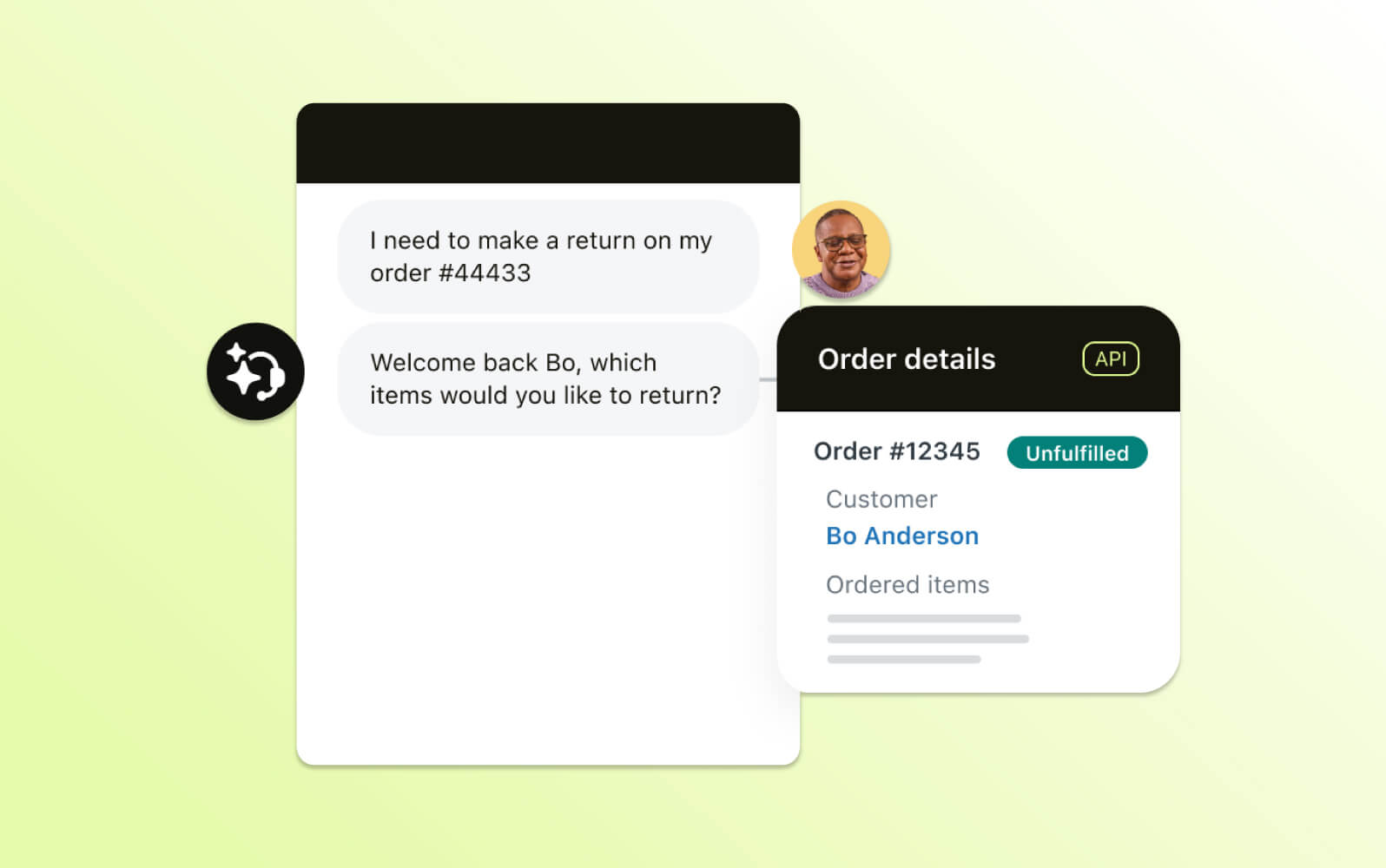
|
Starting price |
Free trial |
Key features |
|
$55 per agent/month (billed annually) Explore more Zendesk pricing plans. |
14 days |
|
Zendesk AI agents stand out in the AI chatbot space by focusing on resolving customer issues, not just responding to them. Powered by agentic AI, these conversational AI bots go beyond basic dialogue to autonomously resolve over 80 per cent of customer and employee interactions across channels like chat, voice, email, mobile, and social media.
Rather than simply guiding customers or handing off issues, Zendesk AI agents are built to complete service requests from start to finish. They can reason through scenarios, access backend systems, and dynamically adapt in real time. This resolution-first approach leads to faster outcomes and more satisfied customers.
Getting started with Zendesk AI requires no specialised training and can be deployed in just three clicks: Naming your AI agent, connecting your knowledge base, and publishing. Most teams are live in under three days. Our intuitive visual builder makes it easy to expand automation and manage complex workflows without code as needs grow.
Zendesk also gives you complete control over how AI agents operate. You can fully automate resolution with Generative AI or define precise workflows for specific scenarios. Businesses can integrate guardrails to ensure brand consistency, accuracy, and compliance, which is particularly important for regulated industries.
Unlike standalone chatbot AI tools, Zendesk AI agents are built directly into the Zendesk ecosystem. This allows seamless access to ticketing, knowledge management, analytics, QA, and more—without the need to toggle between tools or suppliers. This unified approach reduces reliance on multiple platforms, minimises data silos, and improves total cost of ownership.
In addition to direct customer interaction, Zendesk AI provides powerful tools for operations:
- Anticipate needs with AI-powered insights that detect customer intent and sentiment.
- Refine operations using dashboards that track trends and AI performance.
- Automate with precision by offloading triage, routing, and repetitive tasks.
- Generate content instantly with generative AI that turns knowledge base outlines into full articles.
- Improve employee service by resolving internal IT or HR queries as easily as customer ones.
Zendesk designs its AI with privacy, transparency, and security at the forefront. Each AI agent operates within clearly defined accuracy thresholds and adheres to strict compliance standards.
What sets Zendesk AI agents apart is their speed of deployment, scalability, seamless integration, and unwavering focus on resolution. For businesses looking for the best AI chatbot solution to support both customers and employees, Zendesk delivers automation with agency and measurable impact.
|
Pros |
Cons |
|
|
What people are saying:
- “Our sales and customer relationships have been strengthened by Zendesk.”
- “Zendesk is by far the best platform for customer support companies.”
- “Zendesk makes ticketing much simpler.”
- “All-in-one tool to support our clients in different channels.”
2. ChatGPT
Best for general-purpose conversational AI, creative content generation, coding assistance, and broad knowledge tasks
Models: GPT-3.5, GPT-4, GPT-4o
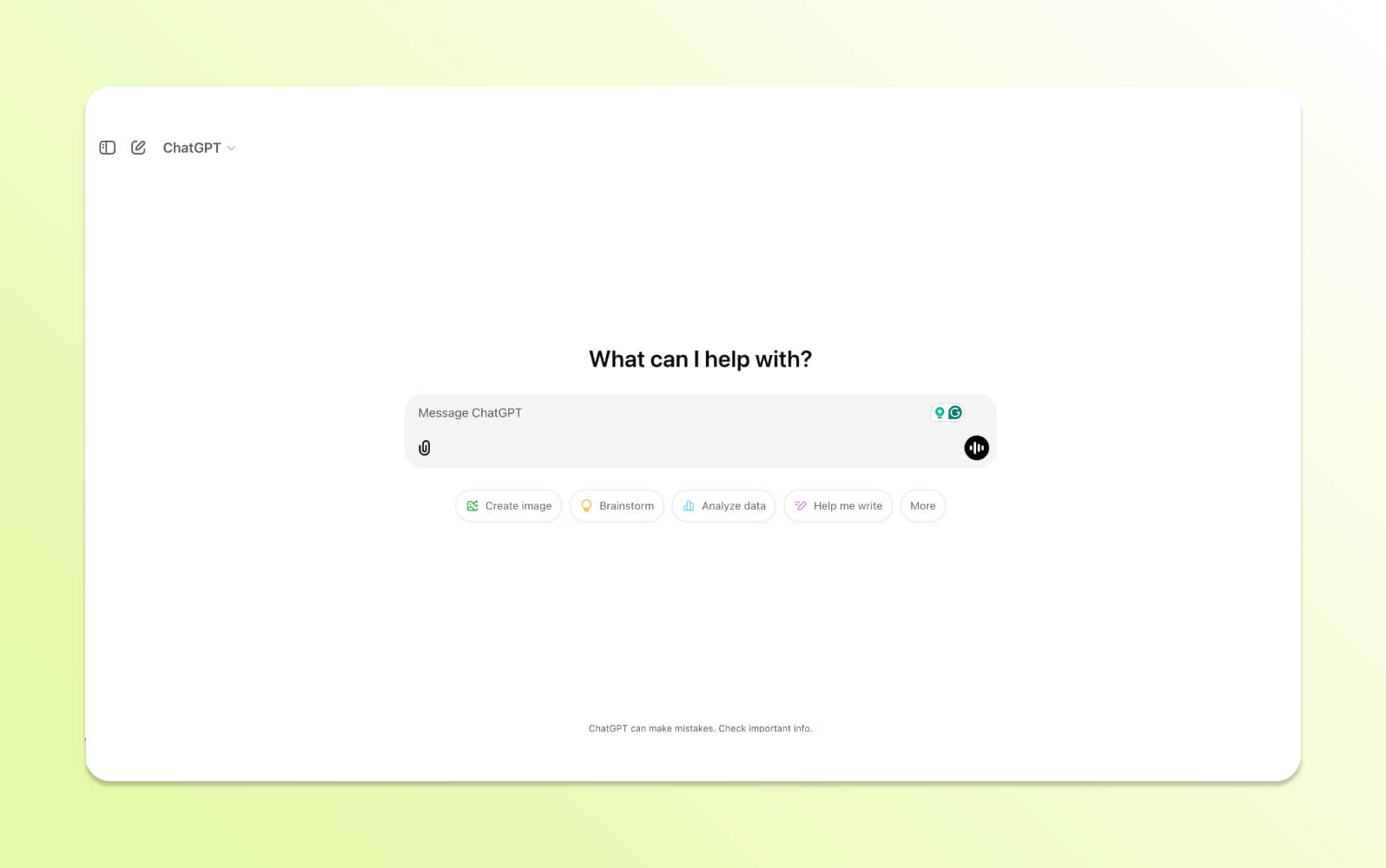
Source: Chatgpt.com
|
Starting price |
Free trial |
Key features |
|
$20 per month |
Unavailable |
|
With AI technology evolving so quickly, OpenAI’s 2022 release of ChatGPT feels like a million years ago. It arguably popularised AI, making generative and conversational AI tools accessible to everyone. ChatGPT handles writing, coding, research, and problem-solving tasks across various domains. It operates through a chat interface where users input prompts and receive generated responses.
Current versions include voice mode for real-time spoken interactions with interruption capabilities and multi-turn conversations. DALL-E integration is available for Plus, Pro, and Enterprise users, supporting image generation through text prompts or voice descriptions.
The platform moved away from plugins in 2024, switching to custom GPTs designed for specific functions. These custom GPTs utilise Actions, or API calls, that integrate with services like:
- Klarna for finance
- Canva for creative design
- Lowe’s for e-commerce
- Speak for personalised language learning
Free users access GPT-4o with usage limits before the system switches to GPT-4o mini. The platform can struggle with context understanding and may generate inaccurate responses. ChatGPT has usage caps on paid plans and maintains an actively developed ecosystem of third-party integrations.
|
Pros |
Cons |
|
|
What people are saying:
- "Feels like having a 24/7 engineering consultant in your pocket!"
- "As a Plus subscriber, I lost 3+ days of work due to export failures — with no clear communication from OpenAI and no visible case tracking [...]"
3. Google Gemini
Best for multimodal understanding and complex reasoning
Models: Gemini (Gemini 2.5 Pro, Gemini 2.5 Flash, Gemini 2.5 Flash-Lite, Gemini Advanced
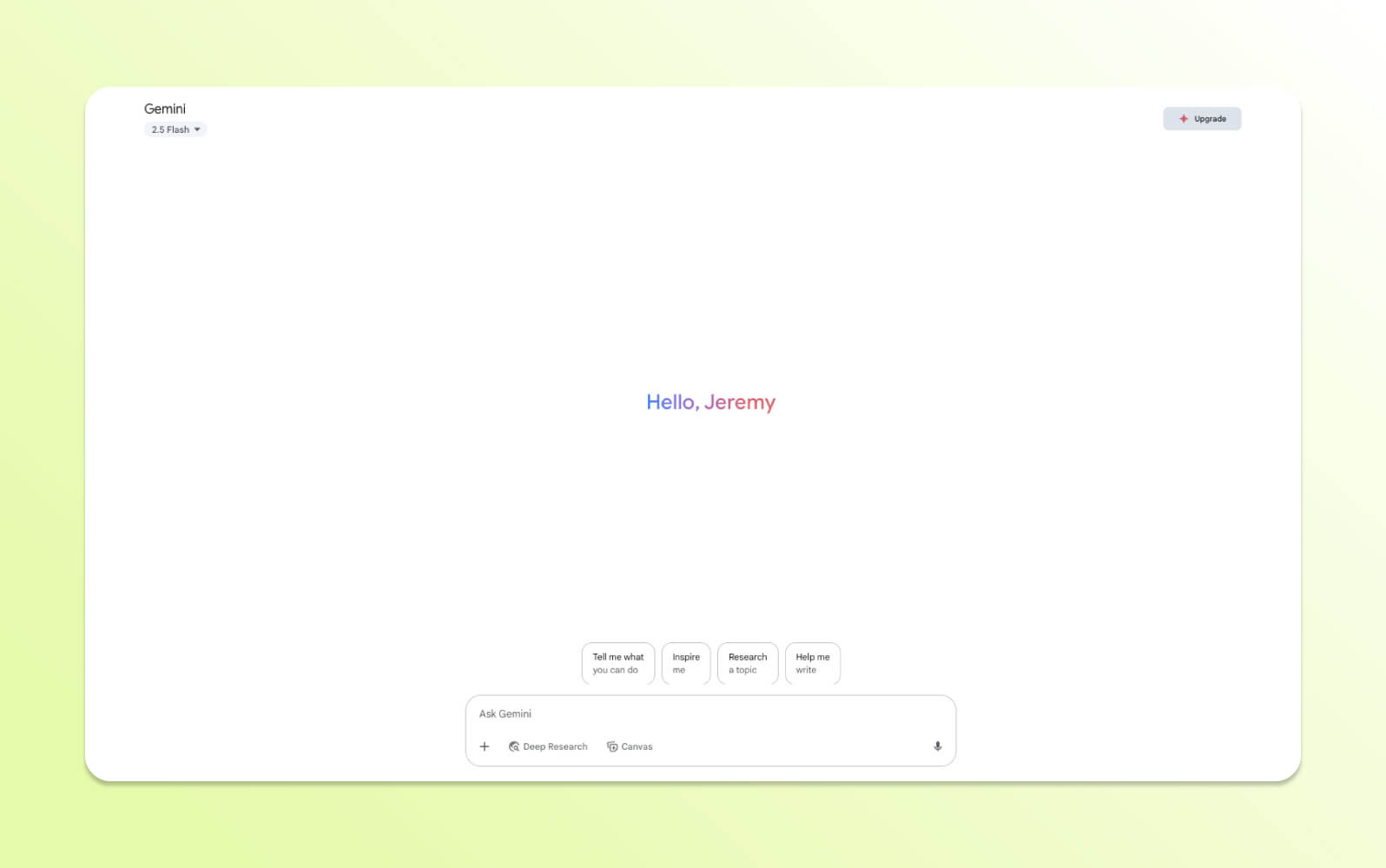
Source: https://gemini.google.com/app
|
Starting price |
Free trial |
Key features |
|
$19.99 per month |
30 days |
|
Gemini is Google's multimodal AI platform that processes text, speech, and images. The system can understand cultural context and communicate across different languages and societies. It handles tasks such as generating responses, creating content, and solving problems that require spatial or logical reasoning.
Gemini includes visual puzzle solving, interactive game creation, and instruction following for complex multi-step processes. The platform offers four model variants:
- Nano for mobile devices such as the Google Pixel 8
- Flash for quick responses
- Pro for complex queries
- Ultra for advanced reasoning tasks and creative work
Gemini Advanced provides context-aware conversations and can function as a tutoring system, generate instructional content, and assist with coding projects. The platform includes trend analysis capabilities and supports content development workflows for teams creating new materials.
|
Pros |
Cons |
|
|
What people are saying:
- “Its ease of use is a standout—onboarding is smooth, the interface is clean, and teams pick it up with minimal ramp-up.”
- “One of the downsides of Gemini is that sometimes it will generate inaccurate results, which you don't want.”
4. Microsoft Copilot
Best for web search, productivity, chat, and image generation
Models: GPT-4, GPT-4 Turbo, DALL·E 3

Source: https://copilot.microsoft.com/
|
Starting price |
Free trial |
Key features |
|
$30 per user/month (billed annually) |
30 days |
|
Microsoft Copilot is an AI assistant for web and mobile applications. The system handles conversational interactions, article summarisation with explanations, email composition, image generation, and routine task assistance, such as meal planning.
Copilot integrates with Bing search to provide AI-powered results with citations. The platform offers a free version with usage caps and is accessible across various browsers and applications, though Edge integration may provide additional features or higher limits for free users.
The system focuses on practical productivity tasks rather than creative conversation. It generates text and visual content while integrating with Microsoft's existing software ecosystem.
|
Pros |
Cons |
|
|
What people are saying:
- “Microsoft Copilot is very simple to use. You write your prompt in the language of your preference, and Copilot presents the answers.”
- “The image generation is not that accurate and lacks in several areas. Frequent disruptions to the service are also an issue.”
Learn more: learn how Zendesk vs. Microsoft compare.
5. DeepSeek
Best for coding, technical tasks, advanced reasoning, and general AI search
Models: DeepSeek V3, DeepSeek R1
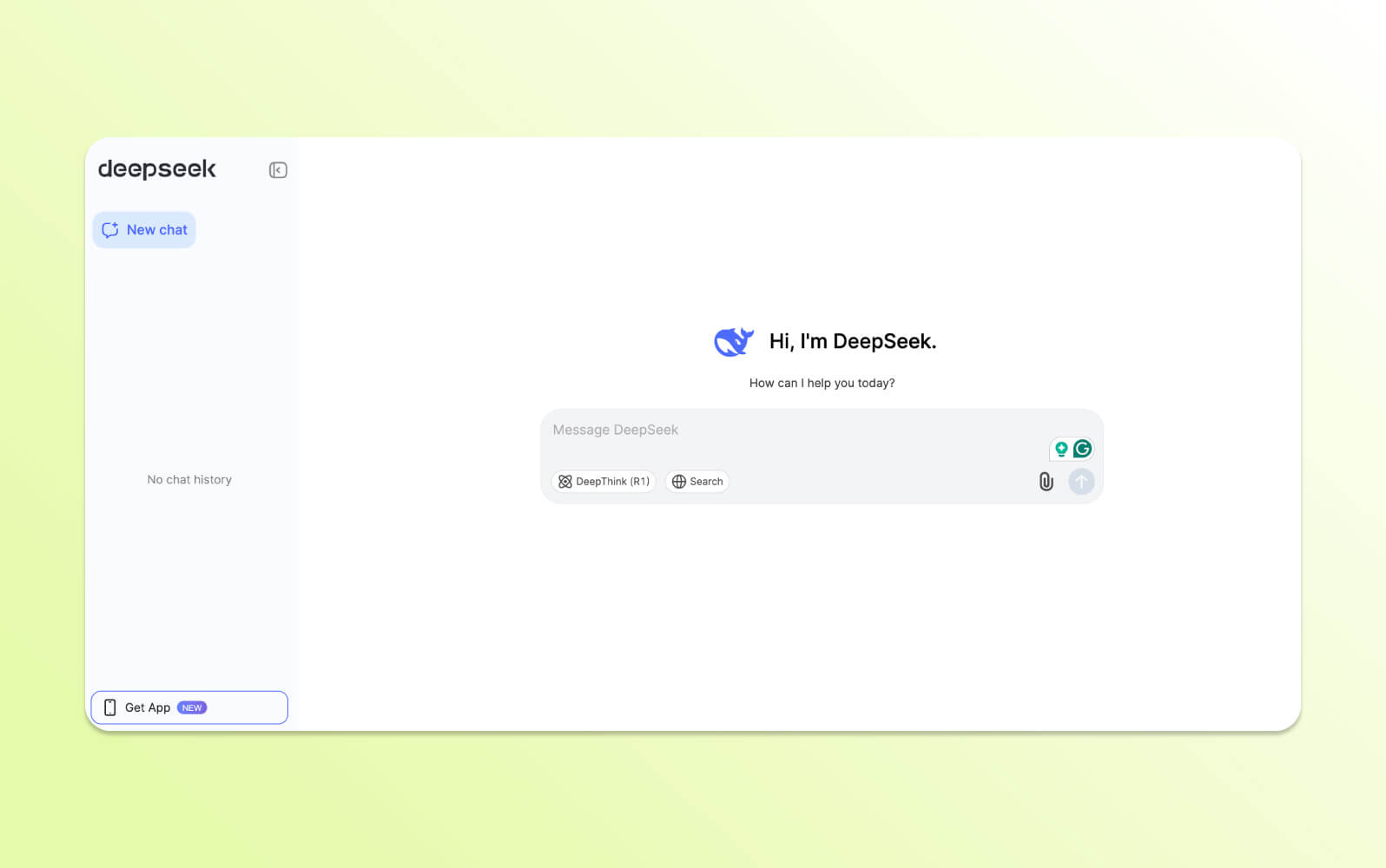
Source: https://chat.deepseek.com/
|
Starting price |
Free trial |
Key features |
|
$0.27 per 1M input tokens and $1.10 per 1M output tokens |
Not applicable |
|
DeepSeek is an AI platform launched in early 2025. The system focuses on language modelling, AI research, and coding applications for developers and software engineers.
DeepSeek Coder V2 provides advanced coding features, including:
- 128k token context window for working with large codebases
- Supports code completion and bug fixing
- Algorithm development across multiple programming languages
DeepSeek LLM manages document analysis, content creation, and can process uploaded files, including PDFs, Word documents, and Excel spreadsheets. It also uses token-based API pricing, which can be cost-effective for high-volume usage but may be challenging to estimate for some users.
It's important to note that DeepSeek operates under Chinese data governance frameworks, which may raise privacy considerations for US and European users.
|
Pros |
Cons |
|
|
What people are saying:
- “Great response with minimum resources! respect.”
- “Deep Seek - Into the unknown.... more like 'into a busy server'. What a waste of electricity.”
6. Claude
Best for creative writing, nuanced conversations, and long-context understanding
Models: Claude 3 (Opus, Sonnet, Haiku), Claude 3.5 Sonnet

Source: https://claude.ai/
|
Starting price |
Free trial |
Key features |
|
$17 per month (billed annually) |
Unavailable |
|
Claude is Anthropic’s conversational AI bot, built using a Constitutional AI framework that prioritises safe and grounded interactions. It supports a wide range of use cases, including content generation, document analysis, and code assistance. It offers a large context window, allowing users to process long or complex inputs more effectively than many AI chatbots. Claude can also handle handwritten text and uploaded images.
While it performs well on nuanced tasks, Claude has limitations. It cannot access web links directly unless used with integrated web search tools, and it may provide inaccurate results if asked to summarise inaccessible URLs.
|
Pros |
Cons |
|
|
What people are saying:
- “[Claude is] really helpful for delving into financials, planning ahead, and breaking big goals into smaller, manageable steps.”
- “Despite all the marketing hype about 'advanced intelligence,' it performs worse than much older AI systems.”
7. Perplexity
Best for research, providing cited and summarised answers with real-time web access and accuracy-focused AI search
Models: Mistral 7B, Llama 2, GPT-4o, Claude, Sonar Large, proprietary models
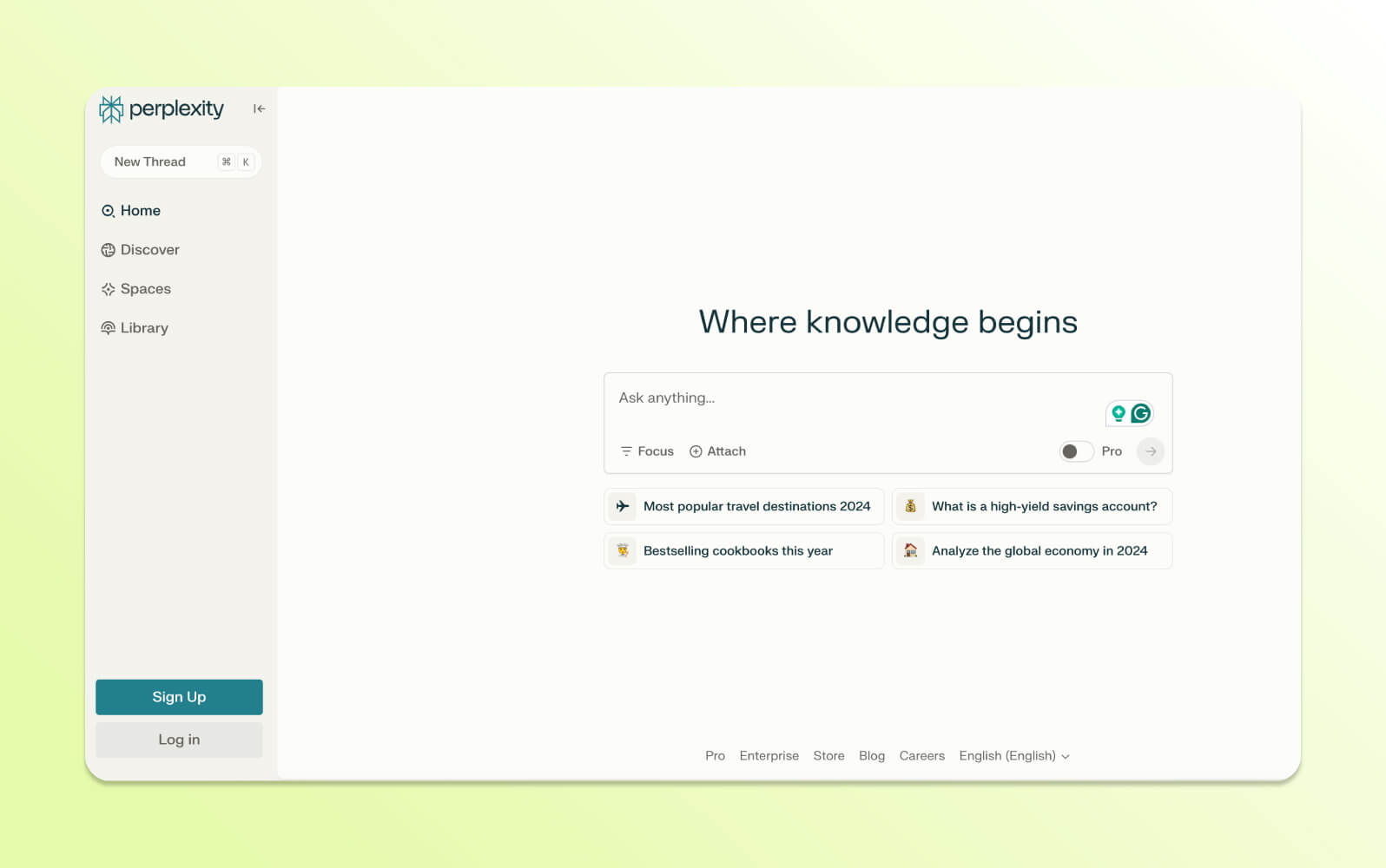
Source: https://www.perplexity.ai/
|
Starting price |
Free trial |
Key features |
|
$20 per agent/month (billed annually) |
Unavailable |
|
Perplexity is an AI-powered search platform that combines natural language processing with real-time web search capabilities. The system provides responses with source citations and references that users can verify independently.
Multiple large language models from providers like OpenAI and Anthropic power its output, enhancing both accuracy and diversity of responses. Perplexity also supports organising research into structured formats through a feature called Pages. It is one of the few top AI chatbots that consistently includes citations and references in its output.
Pro and Enterprise Pro plans include access to advanced AI models, unlimited file uploads and analysis, and image generation capabilities. The free plan includes limited pro queries with basic search and AI response functionality.
|
Pros |
Cons |
|
|
What people are saying:
- “Accurate and reliable responses: The ability of Perplexity AI to deliver real-time answers with high accuracy.”
- “Tone of voice could be improved; sometimes [I] can't find obvious sources.”
8. Meta AI
Best for open-source AI development, general conversational use, and multimodal/multilingual applications
Models: Llama 4 (Scout, Maverick), Llama 3 series
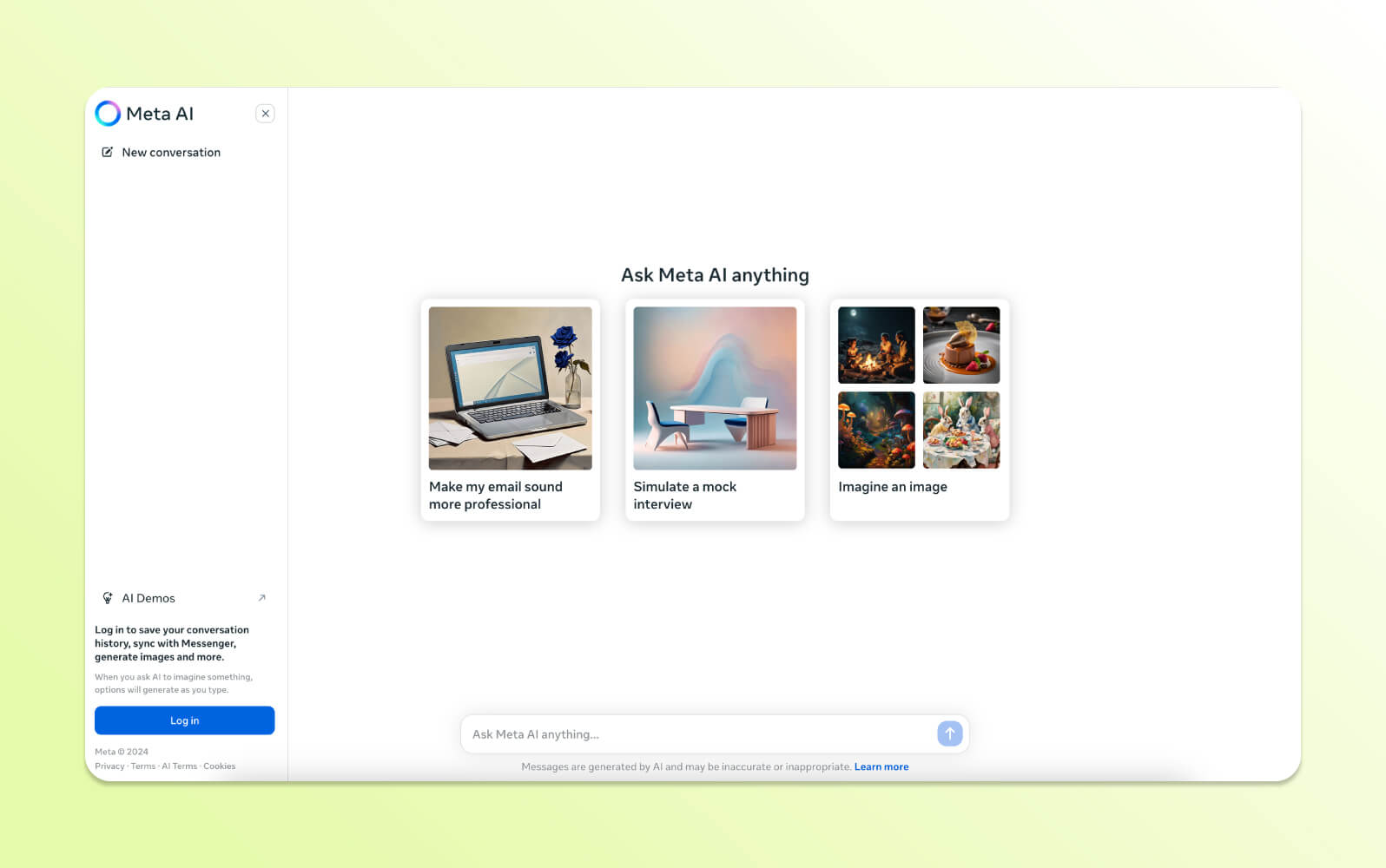
Source: https://www.meta.ai/
|
Starting price |
Free trial |
Key features |
|
Free |
Not applicable |
|
Meta AI is a multimodal chatbot AI integrated across Meta’s platforms, including Facebook, Messenger, Instagram, WhatsApp, and meta.ai. It uses Meta’s Llama models to generate responses across text, image, and audio input types. It is accessible directly within apps that many users already use, which reduces friction and makes it easier to interact with AI without switching platforms.
While its feature set is consistent across Meta’s ecosystem, specific capabilities may vary slightly by application. Meta AI is best suited for general conversational use and social content creation.
|
Pros |
Cons |
|
|
What people are saying:
- “Meta AI can give you assistance with just about anything, from right within your favourite Meta apps.”
- “While it can offer useful summary information, it doesn’t have the deep research skills of ChatGPT or Gemini.”
9. Grok
Best for real-time information access (integrated with X) and engaging in unfiltered conversations.
Models: Grok 2, Grok 3
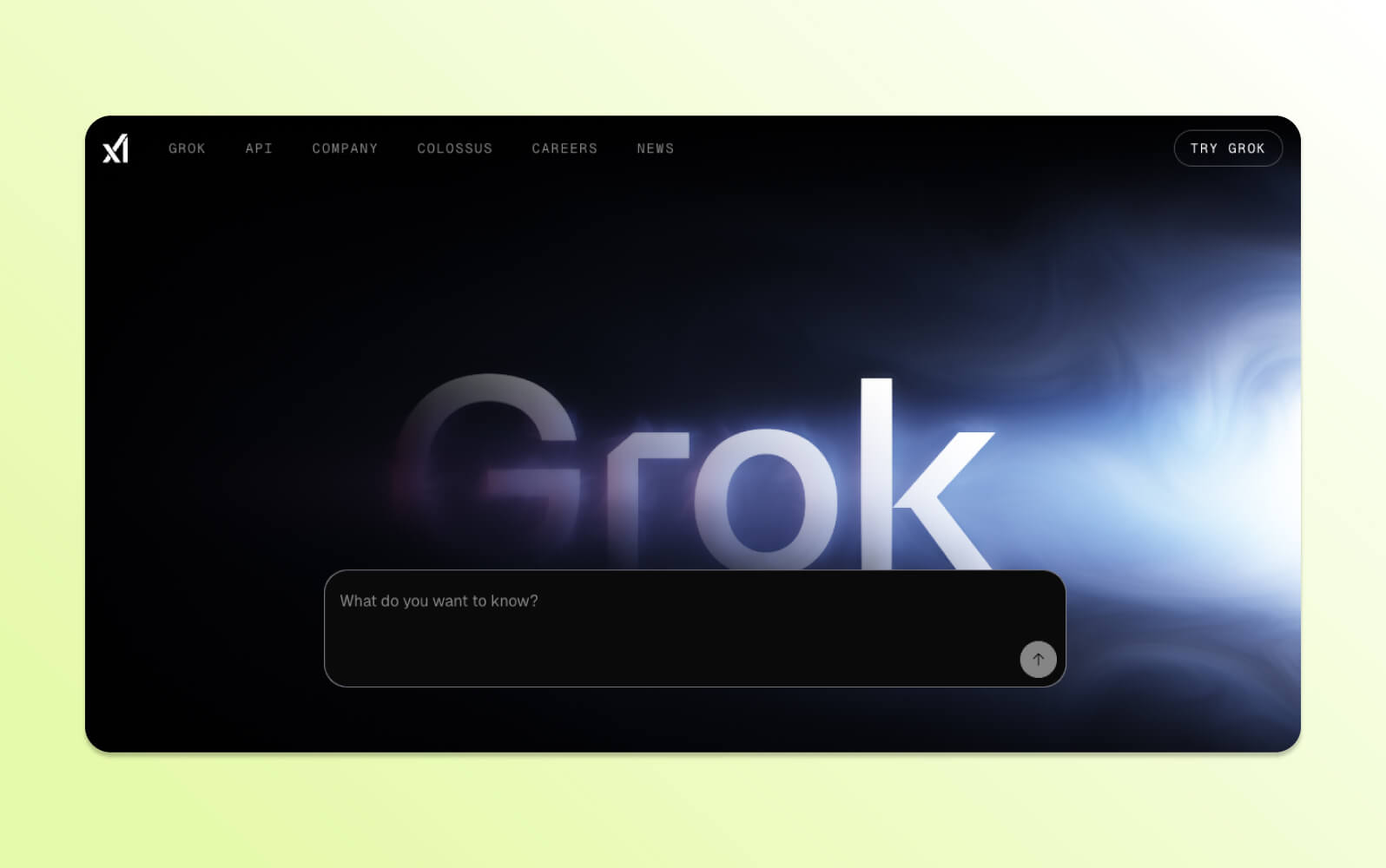
Source: https://grok.com/
|
Starting price |
Free trial |
Key features |
|
$3.00/M, $0.75 per cached input + $15/Minputagent/month (billed annually) |
Unavailable |
|
Grok is xAI's conversational AI assistant that integrates with the X social media platform for real-time information access. The system uses the Grok 3 model, released in early 2025, and includes visual processing, document analysis, and reasoning modes with step-by-step explanations.
This AI chatbot accesses current web data and trending topics through X integration whilst maintaining an informal conversational style. Features include:
- DeepSearch for information retrieval
- Voice interaction features
- Image recognition on iOS devices
The Aurora model generates images with watermarks but limited editing capabilities.
Grok operates on a freemium model with standalone applications, though full functionality requires an X account and a higher-tier subscription. The system's unfiltered approach may not suit professional applications, and accuracy on politically sensitive topics may vary.
|
Pros |
Cons |
|
|
What people are saying:
- “Unlike other AI tools that rely on static or outdated knowledge, Grok provides immediate, relevant insight based on current trends and live conversations.”
- “While Grok’s casual tone is entertaining, it can sometimes come across as overly sarcastic or vague, especially when more structured or professional responses are needed.”
10. Jasper Chat
Best for marketing, branding, and content generation
Models: GPT-4, Anthropic, Google, proprietary models

Source: https://www.jasper.ai/chat
|
Starting price |
Free trial |
Key features |
|
$39 per seat/month (billed annually) |
7 days |
|
Jasper Chat is a business-focused AI platform designed for content creation and marketing materials. It allows users to create content such as blog posts, emails, ad copy, and video scripts, often based on simple bullet points or input prompts.
The system supports multiple languages and enables brand customisation through a Brand Voice feature, helping teams maintain a consistent tone across channels. Jasper also includes built-in plagiarism detection, over 50 templates, and integrates with tools like Google Docs.
It is primarily positioned as an AI chatbot for creative and commercial content workflows. Plans are priced for team use, which may make it less accessible for casual or individual users.
|
Pros |
Cons |
|
|
What people are saying:
- “Jasper is a simple, game-changing tool that has helped streamline our content creation process.”
- “ I tried tweaking how we framed our brand voice on Jasper in lots of ways, but it pretty much gave a similar type of output.”
11. Deep AI
Best for a variety of generative AI tools
Models: DeepCORE

Source: https://deepai.org/
|
Starting price |
Free trial |
Key features |
|
£4.99 per month + overage pricing |
Unavailable |
|
DeepAI is a browser-based AI tool that offers a wide range of generative features, including text-to-image conversion, video creation, and sentiment analysis. It was launched in 2017 and focuses on accessibility, with many tools available without requiring an account.
This online chatbot and creative platform also includes a chat assistant with multiple personality modes (i.e., maths help or relationship advice) and supports basic document analysis.
While its capabilities vary in refinement, DeepAI is positioned as a general-purpose toolset. It appeals to users who need flexible AI bots without the cost or complexity of enterprise software.
|
Pros |
Cons |
|
|
What people are saying:
- “This is a great and very useful tool. It is possible to create without external Experts, [which] saves money and time.”
- “Worked as anticipated until I signed up then it was nothing but rubbish, it a worthless product.”
12. Khanmigo
Best for education and learning assistance
Models: GPT-4

Source: https://www.khanmigo.ai/
|
Starting price |
Free trial |
Key features |
|
$44 per year (billed annually), but free for teachers |
Unavailable |
|
Khanmigo is an educational AI chatbot developed by Khan Academy. It is built to assist students and teachers, offering support for homework questions, lesson planning, and academic review across core subjects. The system uses the Socratic method, prompting learners with questions rather than providing direct answers. This pedagogical design is meant to encourage critical thinking and understanding.
Currently, access is limited to English-speaking countries, with broader rollout plans pending. Its use of GPT-4 places it among the top AI chatbots in the educational sector.
|
Pros |
Cons |
|
|
What people are saying:
- "Overall, I think Khanmigo is a great tool for students and super helpful for homework!"
- “Ok, I suppose, but extremely long-winded explanations that are difficult to understand.”
13. Pi
Best for personal assistance, empathetic conversational AI, and personalised support
Models: Inflection-2.5
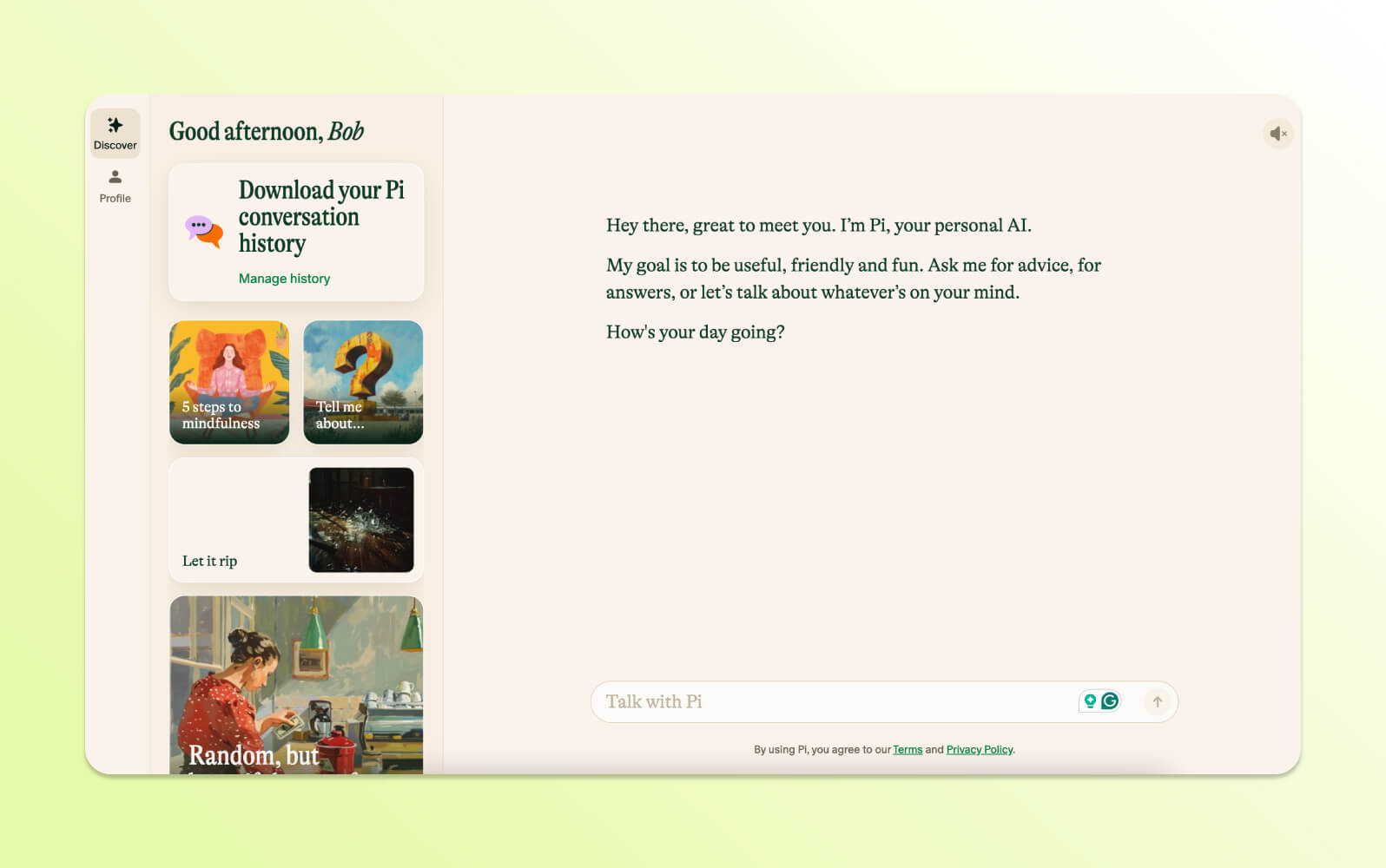
Source: https://pi.ai/discover
|
Starting price |
Free trial |
Key features |
|
$0 per agent/month (billed annually) |
Not applicable |
|
Pi is Inflexion AI's conversational AI bot designed for personal use, emotional support, and general companionship. Its tone is casual and empathetic, with frequent use of emojis and informal phrasing.
It provides advice, brainstorming support, journaling capabilities, and general conversation without making judgements about topics discussed. Pi includes voice interaction capabilities with different voice options and a minimalist interface design. The Discover tab offers conversation Starters and icebreakers for different interaction types.
While Pi has limited flexibility for business applications, it can assist with personal problem-solving discussions and casual conversation needs. Pi’s scope is limited regarding productivity or technical applications, but it may appeal to users seeking a more emotionally engaging AI chat experience.
|
Pros |
Cons |
|
|
What people are saying:
- "The best thing about Pi is how human it can be with its responses."
- "Honestly, Pi kind of annoys me sometimes. Like, it just won’t end. You can’t get an exact number, only estimates—and that gets frustrating when you’re trying to be precise."
14. HuggingChat
Best for user privacy and access to a wide range of open-source large language models.
Models: Llama 3, Falcon, Mistral, and more

Source: https://huggingface.co/chat/
|
Starting price |
Free trial |
Key features |
|
$9 per month (billed annually) |
Unavailable |
|
HuggingChat is an open-source AI chatbot developed by Hugging Face. It provides access to multiple large language models, including Llama, Mistral, DeepSeek, and Mixtral. Users can select from different models depending on their needs, such as code generation, content writing, or spreadsheet support.
This AI chatbot emphasises privacy. Conversations are not used for training or research purposes, and users can download or modify the source code. It also includes optional web search functionality, image generation (model-dependent), and file uploads for document analysis.
HuggingChat appeals to developers, researchers, and users who want full control over their chatbot AI experience without sacrificing capability.
|
Pros |
Cons |
|
|
What people are saying:
- "Easily integrates with other Software and platforms, enhancing functionality and user experience."
- "Users may have concerns about the confidentiality and security of the data shared with the tool."
15. Character.ai
Best for gaming, fantasy, interactive storytelling, and creating and interacting with AI personas
Models: Proprietary
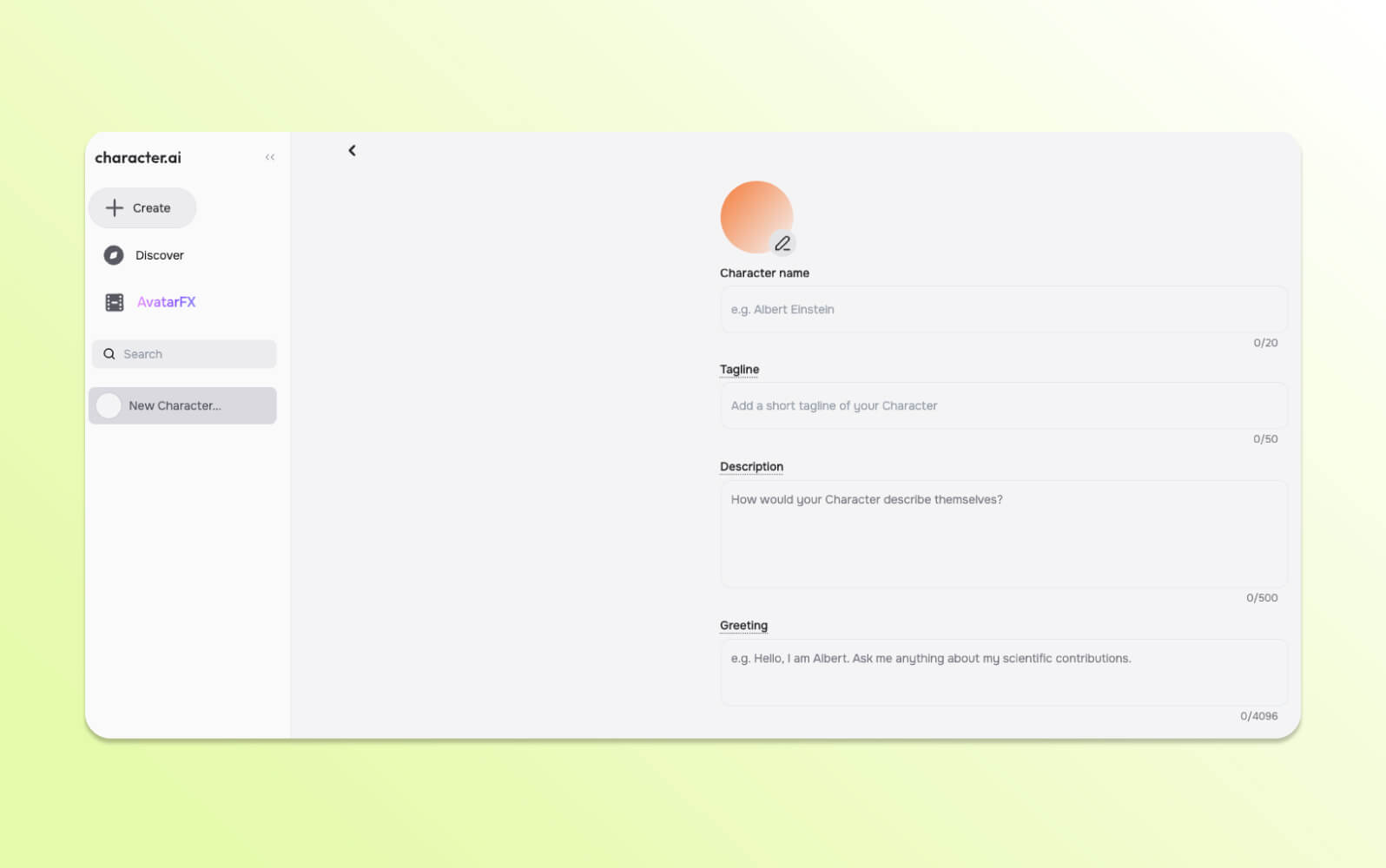
Source: https://character.ai/
|
Starting price |
Free trial |
Key features |
|
£9.99 per user/month (billed annually) |
Unavailable |
|
Character.AI allows users to chat with AI bots modelled after fictional personas, celebrities, game characters, and custom-created personalities. Each AI chat is designed to simulate the behaviour and tone of its character, and users can participate in either solo or group chats.
Users can build their own characters with memory features, adjustable response styles, and model selection (for c.ai+ subscribers). The service includes creative features like text-based game modes and story simulations.
This online chatbot platform focuses on entertainment and creative exploration rather than productivity or research, positioning it among the best AI chatbots for interactive fiction and role-play experiences.
|
Pros |
Cons |
|
|
What people are saying:
- "The ability to have a profile is quite handy, as it allows the background systems to remember what one has written as a way to recommend AIs in the recommended tab."
- “The user interface keeps changing for the worse, the filter activates at times when it is not needed, and the bots disconnect even when I am clearly on Wi-Fi.”
16. Poe
Best for switching between AI models in one place
Model: GPT-4, Gemini Pro, Mistral, Claude 3, Stable Diffusion 3, and more

Source: https://poe.com/
|
Starting price |
Free trial |
Key features |
|
$19.99 per user/month |
Unavailable |
|
Poe, developed by Quora, aggregates multiple AI models—including GPT-4 Turbo, Claude, and Stable Diffusion—into a single interface. Users can switch between models to compare output quality and suitability for different tasks. It supports the creation of custom chatbots via drag-and-drop tools or API integration. Poe also enables monetisation through a creator programme, allowing developers to earn revenue from user interactions.
Poe is aimed at users who want access to top AI chatbots without managing separate accounts, subscriptions, or platforms. Some customisation requires technical skill, but basic chatbot functionality is easy to use.
|
Pros |
Cons |
|
|
What people are saying:
- “I can use lots of different AI tools and chatbots without buying 100 subscriptions.”
- “Terrible, constantly glitching and freezing.”
17. Chatsonic
Best for content creation, marketing, SEO, and real-time data integration
Models: GPT-4o, Claude 3.5, Stable Diffusion, DALL·E 3
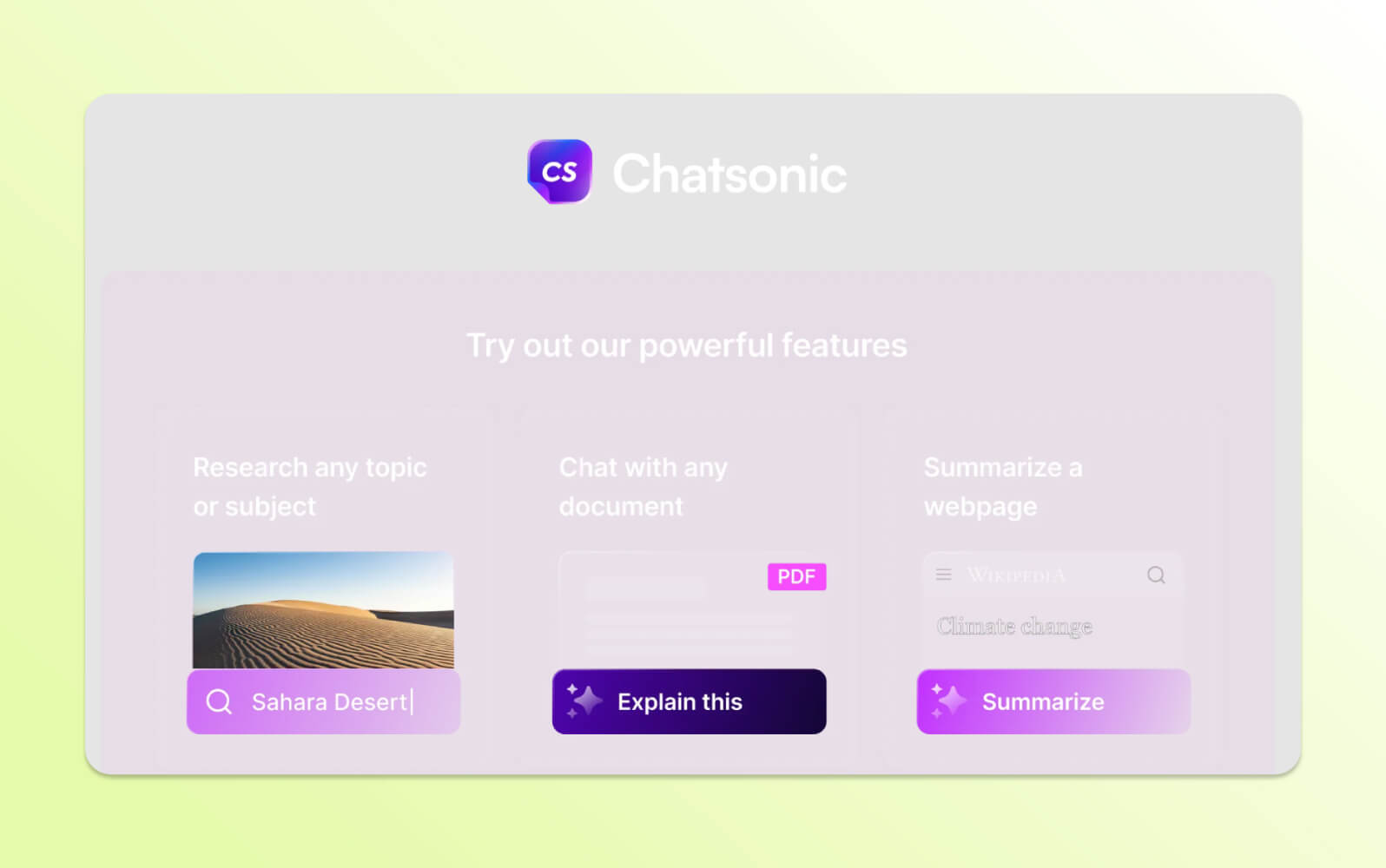
Source: https://writesonic.com/chat
|
Starting price |
Free trial |
Key features |
|
$16 per user/month (billed annually) |
Unavailable |
|
Chatsonic is a generative AI tool that integrates several advanced models, such as GPT-4o, Claude, Gemini, and Flux. Designed for content creation, it offers features like SEO integration, brand voice settings, and compatibility with Ahrefs and Google Search Console.
Agent Mode enables research with citation support, and voice-to-text/text-to-voice options allow spoken interaction. Users can upload files like PDFs and images for analysis, and browser extensions improve accessibility across web platforms. Marketers and creative teams use this conversational AI bot for tasks like blog writing, ad generation, and live data research.
|
Pros |
Cons |
|
What people are saying:
- "Customer service is very helpful and respond quickly if I encounter any problem."
- “So, the only problem I face whilst using Chatsonic is hallucination after having lots of conversations with the AI.”
18. Copy.ai
Best for go-to-market system integration and automating marketing and sales content workflows.
Models: GPT-3.5, GPT-4, Perplexity, Claude 3, and more

Source: Copy.ai
|
Starting price |
Free trial |
Key features |
|
$36 per seat/month (billed annually) |
Unavailable |
|
Copy.ai is designed for marketing and sales professionals who need scalable AI tools for writing emails, social media posts, landing pages, and campaign materials. It supports multiple AI models, including ChatGPT 3.5 and Claude 3.
The AI chatbot features Copy Agents for outbound outreach, integration with CRM and communication platforms like Slack, and centralised knowledge management via the Infobase. Brand Voice tools maintain a consistent tone across all content.
This AI bot is positioned as a high-output content generation system for sales and marketing workflows, especially for teams producing large volumes of copy in multiple languages.
|
Pros |
Cons |
|
|
What people are saying:
- “Copy.AI is time-saving and accelerates content creation by generating high-quality copy quickly, saving my valuable time and effort each day.”
- "The free AI tools still do not work. It's been a week."
19. ZenoChat
Best for: AI writing assistance and content creation
Models: Claude, ChatGPT-4, DeepSeek R1, OpenAI o3-mini, o1-mini, o1
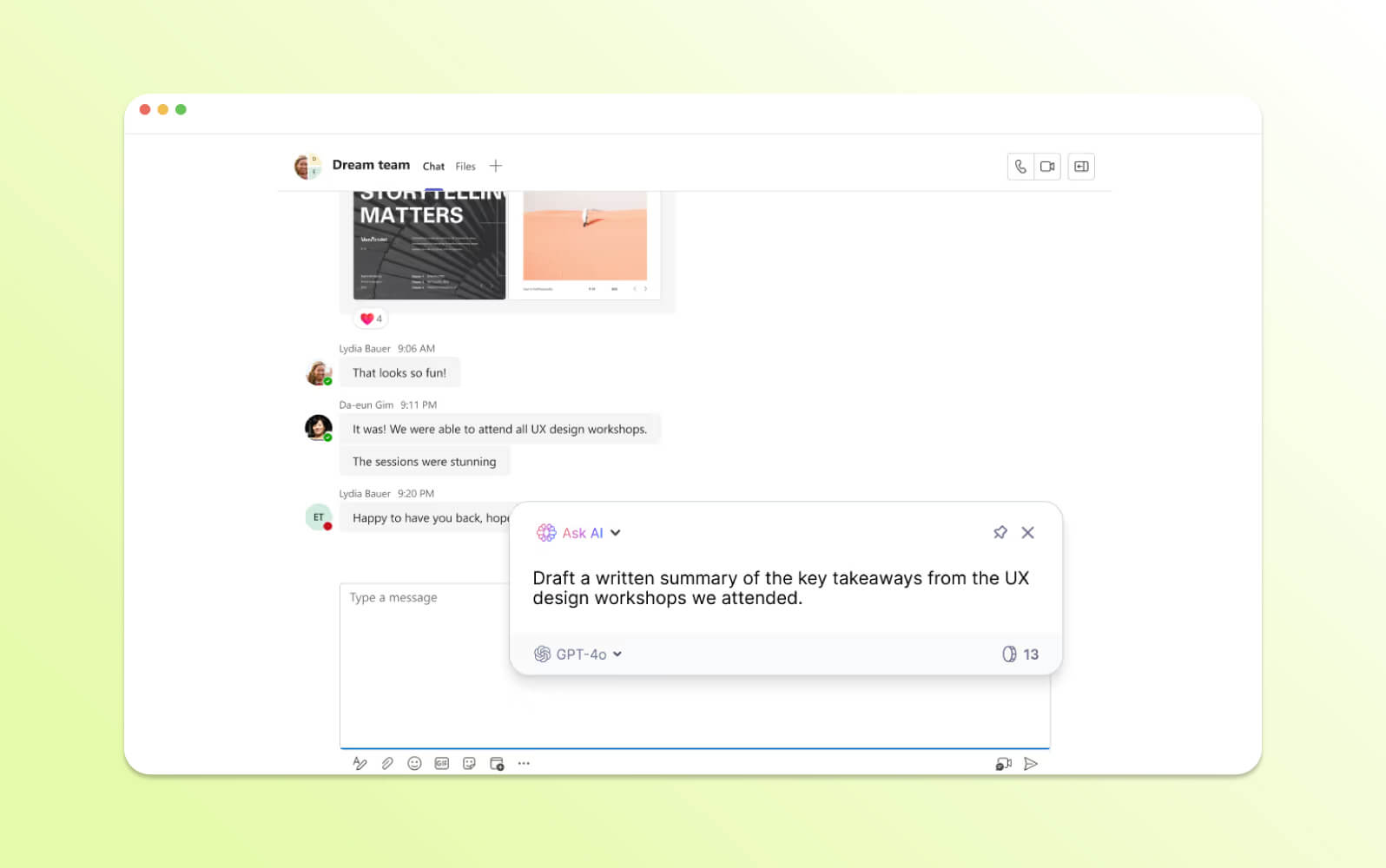
Source: https://textcortex.com/
|
Starting price |
Free trial |
Key features |
|
£5.59 per month, for 150 creations and 100 MB storage (billed annually) |
Unavailable |
|
ZenoChat, developed by TextCortex, is a browser-based AI chatbot that supports over 25 languages and is trained on more than 3 billion sentences. It is focused on writing assistance, content creation, and plagiarism avoidance. Users can create and customise AI personas, toggle web search sources like Google Scholar, Reddit, or custom URLs.
ZenoChat offers a browser extension for seamless integration with other websites. They can also browse a prompt template marketplace. The AI chatbot operates on a freemium model and is frequently used by content creators, students, and professionals needing tailored, multilingual writing support.
|
Pros |
Cons |
|
|
What people are saying:
- “It is one of the best AIs that exist, it helps me a lot in my university work, and the multiple functions it has are marvellous.”
- “Be careful when creating content on academic topics, or that require very deep research and analysis. Some answers may not be entirely accurate, so we advise you to verify the information or answers you get.”
20. You.com
Best for: AI-powered search, conversational AI, and access to various AI models and agents.
Models: GPT-4o, Claude 3.5 Sonnet, Gemini 2.5 Pro (Preview), Gemini 2.0 Flash, Grok 3 Beta, Llama 4 (Maverick, Scout), Qwen2.5, Mistral Large 2, DeepSeek R1, DeepSeek V3, and more
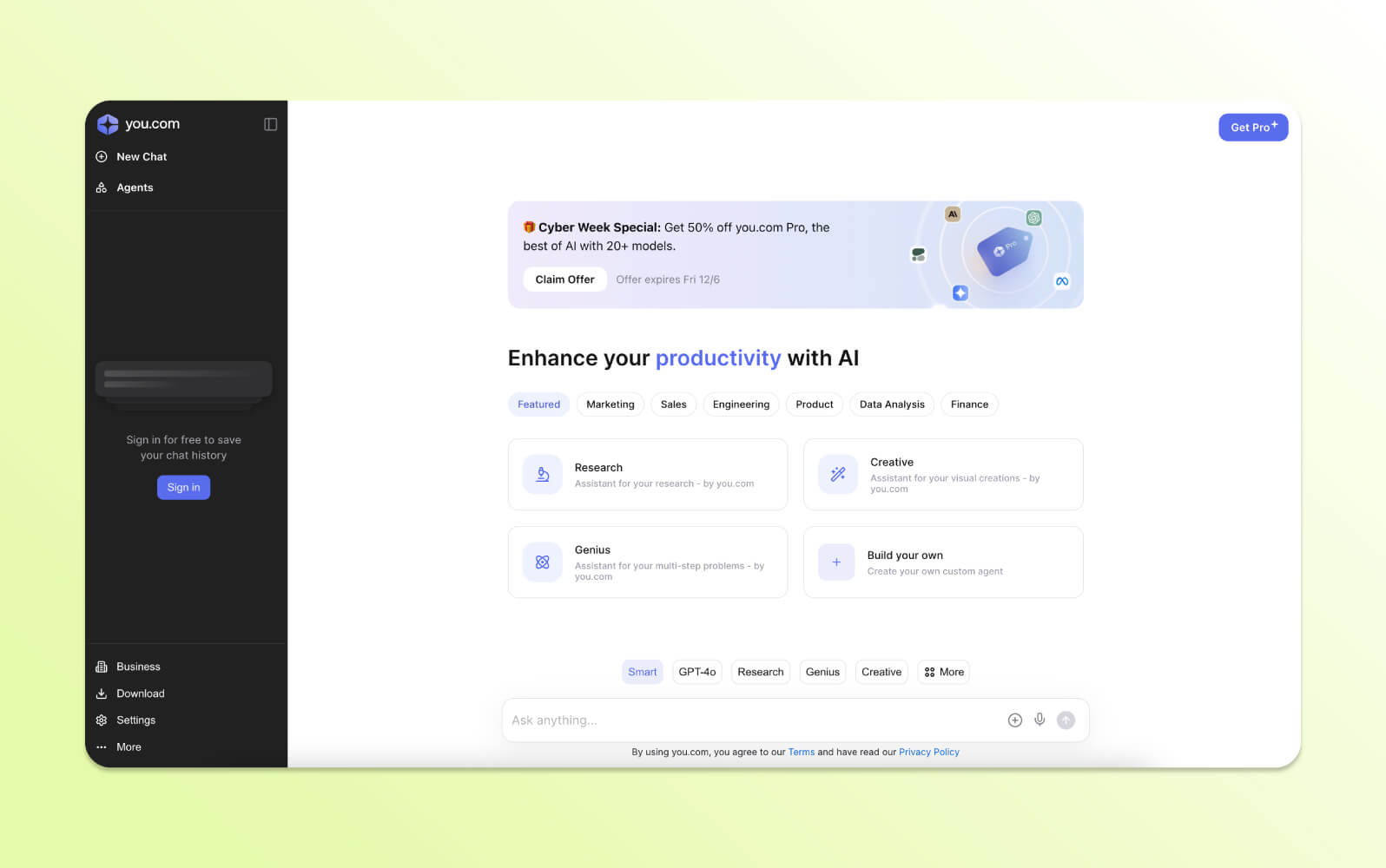
Source: https://you.com/
|
Starting price |
Free trial |
Key features |
|
$15 per agent/month (billed annually) |
Unavailable |
|
You.com combines AI search with conversational AI tools to deliver summarised, real-time results. Positioned as a hybrid between a search engine and chatbot AI, You.com is often used by users who want more interactive and personalised search experiences while preserving control over their data.
You.com offers three modes:
- Genius mode that handles complex problems like equation solving and data visualisation
- Research mode that generates articles with citations
- Create mode, which provides AI art generation, and custom AI agents can be developed for specialised tasks.
You integrate models like GPT-4o and Claude 3.5 Sonnet to support different use cases, including research, coding, and creative generation. Users can upload files, summarise web pages, and build custom AI agents for specialised tasks. Team and Enterprise plans include zero data retention policies, while Pro and Team paid plans offer increased query limits and extended context windows.
|
Pros |
Cons |
|
|
What people are saying:
- “The interface is clean, intuitive, and easy to use, and everything just works seamlessly.”
- “I was on a pro subscription, with access to all the models, and I kept on getting error messages to say I was overusing it. It wasn't working, so I obviously wasn't overusing it.”
How to choose the right AI chatbot software
Choosing the right AI chatbot comes down to finding a solution that aligns with your goals, fits your workflows, and delivers real value to your customers or team. Whether you're aiming to improve customer support, scale conversations, or reduce operational load, here's what to consider as you evaluate your options:

- Start with clear use cases: Define what you need the chatbot to handle — like automating support or driving leads — and choose accordingly. For example, an AI chatbot for sales will differ from customer service chatbots.
- Assess integration capabilities:Check that it connects with your existing messaging software, website, and CRM systems to keep data and conversations in sync. Look for platforms with open chatbot APIs that facilitate connections with third-party applications to keep information flowing smoothly.
- Ensure it has a fast and easy setup: Look for chatbots with pre-trained models that work straight out of the box or can be configured quickly without heavy developer involvement. Quick and easy deployment adds to their total cost of ownership.
- Look for scalability and flexibility:Make sure the chatbot can handle more conversations as you grow, and that you can update or customise it as your needs evolve.
- Prioritise security: The AI chatbot should comply with customer data protection regulations like GDPR or CCPA and offer encryption, privacy controls, and compliance with industry standards.
- Understand the AI model quality:Explore how the bot was trained and what drives it. Look for chatbots powered by advanced language models trained on high-quality, relevant data, with Generative AI and customer sentiment analysis.
- Evaluate support and long-term maintenance: A strong AI as a Service (AIaaS) provider should offer solid documentation, responsive help, and regular improvements that keep the chatbot up to date.
- Use analytics for improvement: Look for built-in reporting tools to track performance, monitor usage patterns, and fine-tune conversations over time.
- Look for customisation and multilingual support: Choose a chatbot that can match your brand’s tone and appearance, and support multiple languages if needed.
- Prioritise AI-to-human handoff: For complex queries, your chatbot should be able to transfer the conversation to a live agent with full context.
These considerations will help you narrow in on an AI chatbot that meets your current needs and grows with your business. The key is that it delivers a better customer experience with every interaction.
Frequently asked questions
See why our AI agents are the best AI chatbots for CX
Don’t settle for inadequate AI chatbots. Zendesk AI agents were trained on billions of customer service data points to help businesses improve productivity and customer satisfaction through intelligent automation. Plus, they set up in minutes, so you can provide AI-powered support from day one. If you need more than a generic chatbot, start building the best AI agent for CX today with a free trial.
Candace Marshall
Vice President, Product Marketing, AI and Automation
Candace Marshall is a seasoned product marketing leader with a passion for solving complex problems and driving innovation in fast-paced environments. Her career began in operations and research, but her love for understanding customers and translating insights into impactful strategies led her to product marketing. Currently, Candace leads product marketing for Zendesk AI including AI agents and Copilot, driving growth across AI-powered solutions and the core service offerings. Her team delivers end-to-end product marketing strategies, from market validation and messaging to go-to-market execution and customer adoption. Before joining Zendesk, Candace spent nearly a decade at LinkedIn, where she built and led the product marketing team for the rapidly scaling Marketing Solutions division, overseeing key advertising products in the multi-billion-pound business.
Related AI chatbot guides
Learn more about using chatbots and messaging to enhance the customer experience.
